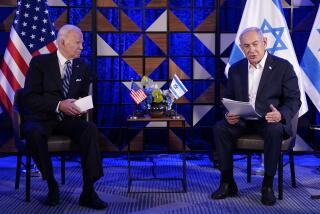India Gets Some Respect
- Share via
WASHINGTON — Last month, the Bush administration signaled its intention to lift limited sanctions the U.S. imposed on India after it conducted nuclear tests in 1998. In effect, the policy change not only admits India into a hitherto closed club of nuclear nations, but also removes sanctions from the kit of U.S. foreign-policy tools in South Asia. Whether the direction of U.S. policy in Asia will change as a result of this single stroke, and whether U.S. nonproliferation policy will be transformed fundamentally as a result of the decision, the removal of sanctions against India may help stimulate South Asia’s historically contentious states to find new ways to get along.
Despite the profound influence the Cold War had on South Asian politics, the U.S. has never been the linchpin of the subcontinent’s daily doings. Indians and Pakistanis often complain about an overweening U.S. presence in the region, but, except for its direct role in Afghanistan’s war, Washington’s effect on South Asia’s strategic relations, economic well-being and societies is generally indirect. The government of India doubtlessly believed this when it tested its weapons, wagering that its expanding economic strength could easily outlast U.S.-led international opprobrium. It was right. The Bush administration’s move to lift sanctions against India not only recalibrates the carrot-and-stick equation in U.S. foreign policy, but it also reflects changing U.S. interests in the region as power balances in Asia continue to shift.
India is understandably pleased with the new administration’s efforts to remove most, if not all, conditions on U.S.-India relations in return for prospective agreement on a range of international issues. Sanctions didn’t really hurt relations; like the nuclear tests themselves, they may have crystallized the differences between the two countries and forced them to rethink their relations. But the sanctions didn’t change nuclear policies and practices, either. In this sense, the Bush administration’s actions may simply acknowledge the failure of one foreign-policy instrument and a preference for seeking new ones. Some commentators believe that the U.S. shelved its objections to India’s nuclear program to make consumers out of India’s upwardly mobile population; others think the U.S. is using India to counter China in Asia’s evolving strategic balance.
Coming in the wake of stalled summitry between India and Pakistan, however, the lifting of sanctions may augur a profound shift in the weight of U.S. interests and patronage in South Asia. After years of intermittent striving against a self-defeating tradition that linked U.S. policy to India-Pakistan relations, Washington has decided that what’s good for the goose is not necessarily good for the gander--or for the U.S. Eight years ago, the Clinton administration appeared to think similarly, but Indo-Pakistan enmity paralyzed U.S. policy along traditional lines. Reiterating its advocacy of nuclear equivalency in U.S. policy, Pakistan now believes that all sanctions imposed on it by Washington should disappear. But if the U.S. resists and stands firmly in favor of separate relationships with India and Pakistan, everyone may stand to gain.
Change is surely needed. This summer’s meeting-without-agreement between India’s Prime Minister Atal Behari Vajpayee and Pakistan’s Gen. Pervez Musharraf was an old-fashioned failure. The status of Kashmir, India’s fragmented democracy, Pakistan’s autocracy and the diverging directions of India and Pakistan’s foreign relations, with nuclear politics as an ever-present backdrop, have been talking points for years. Both sides have consistently refused to sacrifice insular political habits for a wider political vision.
But just as the 1998 nuclear tests reflected different ambitions and intentions in India and Pakistan, so their post-test political courses have diverged. India tested to demonstrate its strength and regional power in a future multipolar world. It has spent the past three years trying to demonstrate that its foreign policy fits its pocketbook, its economic objectives and its half-century determination to be respected as a major global presence. Pakistan’s nuclear test, meant to quell brewing unrest among its political extremists, backfired. It has since rid itself of civilian government, fueled militancy in Kashmir and Afghanistan, supported armed militants at home and tolerated a communal fanaticism that poisons the democratic well at every turn.
Until Pakistan turns its back on intolerance within and near its borders, until it can prove that militants won’t own nuclear weapons and that democrats can live without fear, U.S. sanctions against it are likely to remain. Their effect will be more symbolic than real: Sanctions against Pakistan have failed even more than they did against India, and for far longer. Nevertheless, separate sanctions policies do not condemn the U.S. to separate Indian wheat from Pakistani chaff, any more than they require the U.S. to serve as umpire among Indians, Kashmiris, Afghans, Pakistanis and all the mercenaries who now participate in the region’s conflicts. Instead, they allow the U.S. to give South Asian nations a new incentive to reconcile their differences.
More to Read
Sign up for Essential California
The most important California stories and recommendations in your inbox every morning.
You may occasionally receive promotional content from the Los Angeles Times.










